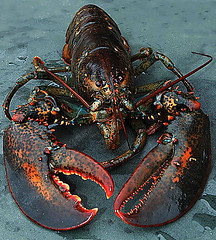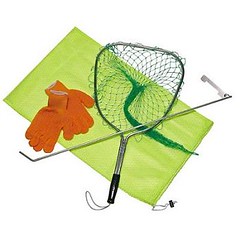When I talk about lobster, most people picture this:
Maine lobster
But I mean this:
Florida spiny lobster
Lobster of the southern Atlantic don't have claws, but their legs and feelers are sharp and will scratch you, so always wear gloves when handling them. They're referred to as spiny lobster, or rock lobster. These lobster typically live under rocks (coral or otherwise) or inside holes in the sea floor. So, to find them, you have to go out on a boat and find a good hole or rock offshore. My dad and relatives have been diving for lobster all their lives and know where/how to look, but if you don't have much experience, it could be difficult to identify a spot. The water depth can vary, but my family has caught lobster in as shallow as 3-4 feet and as deep as about 20 feet. That time, I watched my dad stick his entire arm under a grassy shelf in the sea floor, and shake the shelf so hard that all kinds of stuff started breaking off. I advise against this, both for personal safety (eels and things live in these holes, too!!) and for nature. :)
To catch lobster, you need the following:
- A small net with a handle
- A tickle stick, preferably with a measurer attached
- Dive gloves (if you plan to handle the lobster)
- A net or cooler to put the lobster in, if your boat doesn't have a special area for them
- Plus a mask, snorkel, and fins like you would typically use for snorkeling.
The lobster will probably need to be coaxed out from under the rock, but once they're out, they're fairly easy to catch. They can only swim backward. Dive down with the net in one hand and the tickle stick in the other. Hold the net behind the lobster, and tap it between its feelers with the tickle stick. It should swim backward into the net. Then bring it to the surface and measure it to make sure it's big enough to keep. I don't know much about measurements because I don't do that part, so look it up if you're interested (floridalobstering.com is a good resource). :) If it's a keeper, bring it onto the boat!
Lobstering is unpredictable. You never know how many lobster you might find at one spot. On our first day this time, we visited about 15 holes and it took most of the day, but we also had a lot of people. If your limit is lower, it won't take as long! The Florida season runs from August to March, and the limit is 6 lobster per person per day (after purchase of a saltwater fishing and lobster license).
I'm usually more of a spectator on our dive trips, but this time I caught a few lobster myself! It was exciting. However, I don't participate in the cleaning or cooking of the lobster. They're usually still alive when you start cleaning them up, and I CANNOT actually kill a living creature (other than the occasional bug, and even then I don't like it). I enjoy catching seafood, but I won't deliver the death knell. I know that's very inconsistent of me, but I'm okay with it. :)
Here are a few lobstering pictures from last week!
Thousands of miles southeast of Dutch Harbor...
42 the first day, 48 the second day!








Wow, that's really neat how you catch them! Though I still think they're mighty creepy looking!
ReplyDeleteThis was fascinating! Thanks for writing it up!
ReplyDelete